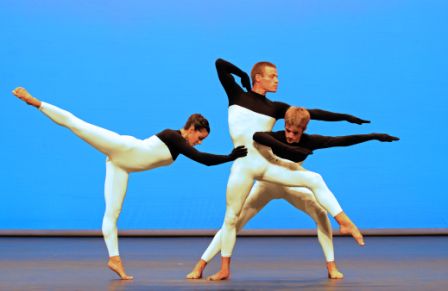The Lyon Ballet is here–at the Joyce, with a great program that feels as if it’s made for New Yorkers (no Eurotrash, for example, or almost none). It includes Cunningham’s Beach Birds, which the dancers do with loving conscientiousness, if not quite the amplitude and eccentricity of the late choreographer’s own, soon to be “redundant” (as the British put it) dancers.
Anyway, here’s the first few paragraphs of the Financial Times review coming out tomorrow:
The Lyon Ballet gives the ubiquitous category “contemporary dance” a good name by doing something else. The company’s repertory is distinguished not by attitude – complacent gloominess, say, or cool sexiness – but by language, startling language.
The programme at the Joyce this week concludes with Maguy Marin’s cutesy take on Sisyphus, in which people roll the rock up the hill not because that’s life but because they are obsessive-compulsive. But the evening begins with Merce Cunningham and William Forsythe. Typically American in their strivings, these choreographers do not care what the movement says, they care what it does. Advocating nothing, they offer the vast, disinterested freedom of art.
In Forsythe’s 1996 Duo, Dorothee Delabie and Amandine François appear on a pitch-black stage lit by a single fluorescent tube. In sheer black above the waist, the women’s pale breasts stand out in the gloom, as does the S-curve of ballet lines – one arm overhead, a leg crooked behind. Forsythe takes the classical torso’s basic torque and, like an accordion, expands and compresses it into various patterns and rhythms. The effect is mesmerising.
Where Forsythe emphasises the body’s unity, Cunningham celebrates the independence of one part from another. In the 1991 Beach Birds, he does so via the quirks of birds. Transposing the vibration of wings to lower leg, and bird-hover to dancers facing each other in stillness, he awakens us to the creatures’ strange beauty, and to our own.
In one of many trios that form serendipitously in this translucent, spacious work, two dancers gently push and pull a third into various positions while carrying on a duet between themselves. The third dancer does not partake in their twosome, though they form a trio with him. He has one role: belong. They have two: take care of him and love one another. Cunningham conveys all this in an avian instant.
When the late choreographer’s orphaned company completes its final world tour in 2012…
For the whole thing, click here.
 A gorgeous eccentric tableau–formed and dispersed with animal swiftness–in Cunningham’s Beach Birds, one of his most spacious and translucent works. Photo by Jean-Pierre Maurin, courtesy of the Lyon Ballet.
A gorgeous eccentric tableau–formed and dispersed with animal swiftness–in Cunningham’s Beach Birds, one of his most spacious and translucent works. Photo by Jean-Pierre Maurin, courtesy of the Lyon Ballet.

Leave a Reply